

Back to: PJWs ATLATL
(up-dated 5/March/2013)
The core:

 The core weighs 6.6gr.
The core weighs 6.6gr.
Below, is the layout of the hourly locations, of the core drilling, on the core.
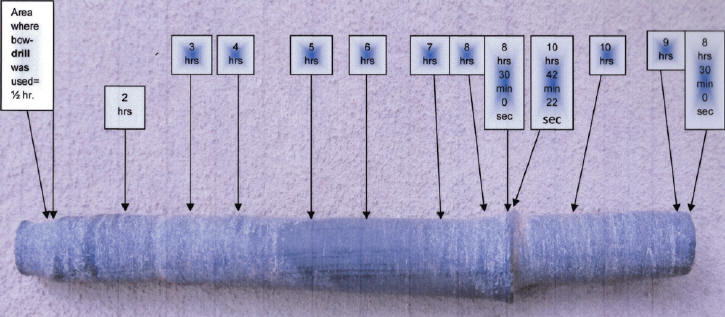
Notice, that the core shows deeper wear in the area where the bow drill was used (and slightly above it). The bow drill area yielded about 1/2mm of cutting, per 1/2 hour, whereas the hand-drilling, above and below that area, was at least 5 times more efficient (3-1/2mm above, per1/2 hour and 7mm, per 1/2 hour afterward. The bow drill also seemed to wobble much more than the hand drill. That seems to be the reason why the area above the bow-drilling is cut into the core more than any other place on the core. Larry believes he can improve his efficiency, by as much as 1/2 hour, by using the hand-drill only. Larry also experimented with the bow-drill on an earlier bannerstone and found it to be ineffective because it spun the drill to quickly, throwing the abrasive chert dust away from the cutting portion of the cane. At approximately the 1-1/2 hour mark, Larry started using a wet towel, placed nearby, to wet his hands. As time went by, he wetted his hands more often so that from about the 5 hour mark onward, he was wetting his hands every 2nd pass down the drill. Larry averaged around 5 passes down the drill per minute. It took around 642.5 minutes to drill PJW's banner so, if we multiply that figure by 5, we arrive at approximately 3,212 passes, to drill the bannerstone.
Also notice that the area from 7 hours to 8 hours-30 minutes, shows a decline in productivity. That was the area where the cane core-drill started to split (at about 7 hours) and productivity slipped from 7mm per hour to just over 1mm per hour. The reason for this poor productivity wasn't realized until the core was removed and observed. The split cane drill flared outward (notice the larger diameter of the core from 8 hours to 8-1/2 hours) making the cane wear faster and making the drill cut a larger area. Larry believes he can cut production time by about 1 to 2 hours, by replacing the cane drill (or cutting it back to a new edge, at least) whenever splits occur. If Larry is correct, he can be even more productive (from 1-1/2 hours to 2-1/2 hours) by using only hand-drilling, replacing the cane, when it splits, and wetting his hands often. Those corrections would place the drilling time closer to 8 hours, rather than 10 hours, 42 minutes, and 22 seconds.
 Here's the core as it was released. Notice the clay,
adhering to the stone.
Here's the core as it was released. Notice the clay,
adhering to the stone.

 At this point, the bannerstone weighs 181.2 gr.
At this point, the bannerstone weighs 181.2 gr.
 Here's what the cane core-drill looked like at the
8-hour mark. Larry didn't realize at the time that the splits in the cane
severely hampered the drilling and efficiency. Once the core was removed, he
could see that the split cane flared out and drilling was hampered.
Here's what the cane core-drill looked like at the
8-hour mark. Larry didn't realize at the time that the splits in the cane
severely hampered the drilling and efficiency. Once the core was removed, he
could see that the split cane flared out and drilling was hampered.

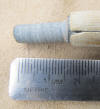 After the drilling was complete. Larry placed the cane
drill onto the core and was able to find out what had happened. the splits had
caused the drill to flare outward. Larry now knows that, when drilling a
bannerstone, if the cane splits, replace it of cut off the damaged area.
After the drilling was complete. Larry placed the cane
drill onto the core and was able to find out what had happened. the splits had
caused the drill to flare outward. Larry now knows that, when drilling a
bannerstone, if the cane splits, replace it of cut off the damaged area.
 Here, the cane core-drills are laid, end to end,
to show what had happened to each drill.
Here, the cane core-drills are laid, end to end,
to show what had happened to each drill.


 This is how badly cane core-drill #1 split
This is how badly cane core-drill #1 split
 Weighing the cane micro-drill handle (without
micro-drill) = 24.4gr.
Weighing the cane micro-drill handle (without
micro-drill) = 24.4gr.
 Weighing
cane core-drill #1 = 46.8gr.
Weighing
cane core-drill #1 = 46.8gr.
 Drill #2 weighed 24.0gr.
Drill #2 weighed 24.0gr.
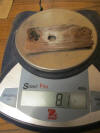 Template #1 weighed 8.1gr.
Template #1 weighed 8.1gr.
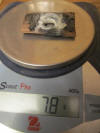 Template #2 weighed 7.8gr.
Template #2 weighed 7.8gr.
Here's the finished bannerstone:
(bottom length=6.2cm) (side -1 thickness=3.1cm) (side-2) top width=5.0cm) (1st end)
(2nd end) (finished weight-162.8gr) (antler hook weight=28.6gr) (hook hole) (antler hook close-up)
(Antler handle, front=8.8cm long) (Antler handle, back width=4.2cm) (Handle, side 1 thickness=3.0cm) (Handle, side 2)
Antler Handle weight = 127.8gr.
![]() The river cane main-shaft. It weighed 27.6gr.
The river cane main-shaft. It weighed 27.6gr.
Gluing the antler handle, to the main-shaft, with asphaltum.
http://www.youtube.com/watch?v=kDpzl4B4L9k&feature=plcp
Gluing the antler hook, to the main-shaft, with asphaltum.
http://www.youtube.com/watch?v=k9HXDokFKaE&feature=plcp
The finished atlatl.ain-sh
aft: weight:
(Top) (Bottom) (Weight=317.5gr)
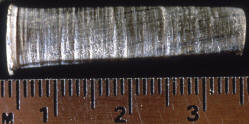 (Photo Pete Bostrom)
(Photo Pete Bostrom)
Julie's core = 30mm. Drilling time = 10 hours, 22 minutes, 0 seconds. Cane loss = 30mm. (above)
PJW's core = 65mm. Drilling time = 10 hours, 42 minutes, 22 seconds. Cane loss = 93mm (below)
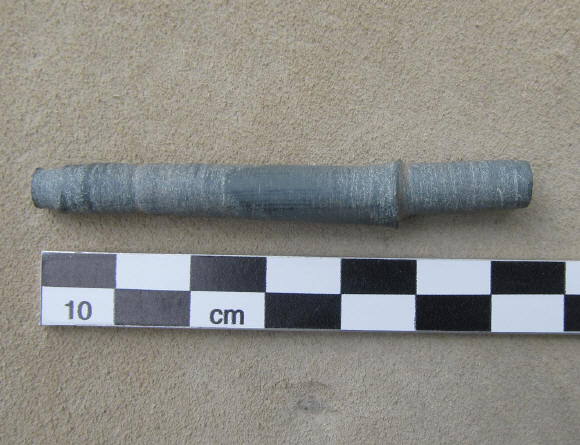
The first bannerstone core was cut from Julie's bannerstone (started--5/Nov./1989, ended--3/Dec/1989). The second, from PJW's (started--21/Aug./2012, ended--31/Aug./2012). There was only a 20 minute, 22 second difference, in drilling time, between the two experiments, to achieve a core over twice as long. Therefore, Larry was able to double his drilling efficiency simply by wetting his hands often, and using a template to start the perforation. Because of the inefficient behavior of the cane drill (when it split) and the inefficiency of the bow-drill, Larry believes he could have saved as much as 2-1/2 hours by hand-drilling only, wetting his hands often, using a starting template, and replacing the cane, when it split. Larry plans to use that information when he drills his next bannerstone.
Larry averaged around 5 passes down the drill per minute. So, he estimates he used about 3,110 passes to drill the bannerstone.
Stay tuned!
Back to: PJWs Atlatl